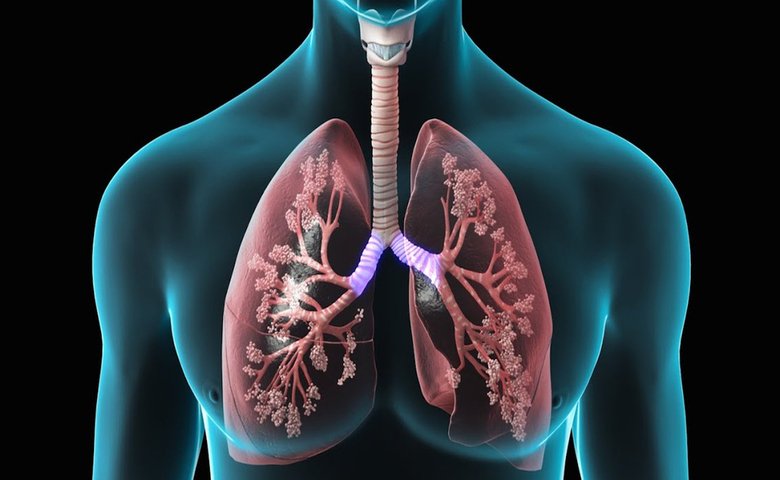Cheyne-Stokes Breathing is a particular type of periodic breathing that involves a climax rhythm of breathing in between the central apneas or central hypopneas. Many people search for Cheyne-Stokes Breathing causes and treatments. Heart failure and stroke are the most common causes of Cheyne-Stokes respirations. Cheyne-Stokes breathing is seen in 25% to 50% of patients with heart failure, although being unusual. Here, we are trying to explain Cheyne-Stokes Breathing causes and treatments in detail.
Table of Contents
The “Death Rattle”
Even while it may be unsettling to refer to this sensation as the “death rattle,” it is an accurate description. The medical term for saliva and mucus accumulating in the airway when a person becomes too weak to expel those secretions is “end-stage wet respirations.”
When the person breathes, the mucus and fluid build-up makes a rattling sound. When family and friends learn this, they may become upset. However, the patient is frequently not in pain or suffering.
Cheyne-Stokes Breathing
Here, you will learn about Cheyne-Stokes Breathing causes. Breathing can be exceedingly quick and deep (hyperpnea) during Cheyne-Stokes, followed by periods of slow shallow breathing, or interrupted by apneic episodes, during which the person stops breathing entirely for a while. The breathing of Cheyne Stokes may seem random, yet it frequently happens in cycles that span between 30 seconds and two minutes.
This erratic, frequently unsettling breathing pattern is frequently observed in the final days and hours of life, but it can also occur in some persons with congestive heart failure.
Causes of Cheyne-Stokes Breathing
When a person is nearing the end of their life from any condition, including cancer, Cheyne-Stokes breathing is frequently observed. This will be covered first, but keep in mind that there are additional causes that are covered lower down and that persons who are not actively dying may still experience this breathing.
Other Causes of Cheyne- Stokes Breathing
In addition to being an end-of-life occurrence, Cheyne-Stoke breathing may be seen with:
- Congestive heart failure
- Carbon monoxide poisoning
- Hyponatremia (a low sodium level in the blood)
- Taking a nap at a high altitude
- Stroke
- Harm to the brain from trauma
- Several drug overdoses, including morphine
Congestive Heart Failure with Cheyne-Stokes Breathing
Congestive heart failure patients frequently experience Cheyne-Stokes breathing, which is seen as a bad prognostic symptom. Nevertheless, some persons with Cheyne-Stokes breathing brought on by heart failure go on to enjoy long lives.
Heart failure occurs when the heart (as a muscle) becomes weakened and has difficulty pumping blood. Similar to other muscles, progressive weakening can lead to the progressive inability of the heart to function in blood circulation to supply oxygen and nutrients to the cells of the body.
Cheyne-Stokes Breathing as a Symptom of Dying
At the end of life, breathing irregularities are possible and can be quite upsetting for present family members. It’s vital to notice that the dying person’s breathing is not painful and doesn’t require any comfort measures. In fact, it’s probably the body’s attempt to make up for other physical changes that occur toward the end of life.
What more might be in store for you as you approach death, you might be wondering. People frequently remark about seeing loved ones who have passed on during this period, sometimes even acting frustrated as they attempt to describe things for which they seem unable to find words. In a state of “near-death awareness,” your loved one can express her intention to depart from you and tell you she will miss you as she passes away. Those who are close to death may find it upsetting to hear their remarks brushed off as hallucinations or to have them corrected. When your loved one is awake, try to talk to her and tell her that you care about her.
Summary
A person may exhibit a number of symptoms as they draw closer to the end of their life. Some symptoms of a loved one who is dying include pain, shortness of breath, anxiety, incontinence, constipation, delirium, and restlessness.
I hope this would help you to learn what is Cheyne-Stokes Breathing causes and treatments.
Frequently Asked Questions
1. How long is the duration of Cheyne-Stokes breathing?
What breathes Cheyne-Stokes? Periodic respiration, also known as Cheyne-Stokes respiration, involves an unusual breathing pattern. We can characterize it by cycles of deep breathing and shallow breathing. Each cycle lasts, on average, between 30 and 2 minutes.
2. How does Cheyne-Stokes result from cardiac failure?
In patients with heart failure and stroke, the PCO2 levels during hyperventilation will fall below the apnea threshold levels, leading to apnea once more because of unstable central control and imprecise feedback support. Cheyne-Stokes respiration is caused by these ongoing bouts of apnea and hypercapnia.
3. What distinguishes agonal breathing from Cheyne-Stokes breathing?
Two doctors, Drs. John Cheyne and William Stokes initially described Cheyne-Stokes or Hunter-Cheyne-Stokes breathing in the 1800s. Unsurprisingly, Cheyne-Stokes respirations are an extremely erratic respiratory rhythm that is commonly referred to as “agonal breathing.”
4. What is the Treatment for Cheyne-Stokes?
For central sleep apnea with Cheyne-Stokes respiration (CSA/CSR), a number of potential therapies exist, such as CPAP, adaptive servo-ventilation (ASV), and nocturnal oxygen therapy. The advantages of these treatments for CSA/CSR patients who also have concomitant heart failure (HF) are still debatable.
5. What occurs in the final hours before passing away?
Most people deteriorate as they lose more blood in the final hours before death. Their skin turns chilly to the touch, they sleep a lot, and their respiration becomes erratic. Those who do not pass away days before losing consciousness frequently do so in the hours prior.
6. What happens just before death?
The jaw may drop and the facial muscles may relax. Skin can turn extremely pale. There may be quiet breathing followed by harsh, rasping gasps. In their latter stages, dying patients frequently only breathe sporadically, taking a breath, then holding it for a few seconds.
7. How is breathing affected by heart failure?
Breathlessness, which may occur after exercise or when at rest and may be worse when you’re lying down, is one of the most typical signs of heart failure. You may also wake up in the middle of the night wanting to take a breath.
8. What sounds does someone breathing their last make?
Each breath produces a different intensity of the crackling, wet sound known as the death rattle. The sound can occasionally be muffled and moaned-like. It can also be loud and audible, like snoring or gargling. It may seem as though the person is “drowning” or choking, which can be upsetting to loved ones.
9. Before dying, how long does gasping last?
The final respiratory pattern before terminal apnoea in a dying patient is gasping respiration. The gasping respiratory phase can continue anywhere from a few seconds to minutes or even hours. It can also be as brief as one or two breaths.
10. Which sensation leaves the body last?
The last sense to go, according to popular belief, is hearing.
11. Which four symptoms characterize heart failure?
breathlessness while moving around or upon lying down. weakness and exhaustion. Legs, ankles, and feet swelling irregular or fast heartbeat.
12. What is the name of the final breath before passing?
Agonal respiration, another name for gasping, is a fitting description because the patient appears to be in pain and appears to be gasping during the respirations.
13. What indicates a person’s final days?
Breathing problems. Patients may breathe rapidly for long stretches of time before doing so again.
- Blood pressure and body temperature drop
- Less appetite for food or beverages
- Changes in sleeping habits
- Confusion, or retreat
14. What time of day do people often pass away?
Death can occur at any time; there is no set time when it will happen. However, according to other studies, the majority of fatalities happen at night, and the most dangerous hour is between 3 and 4 in the morning. Most hospital deaths, according to the study, happen between 3 and 4 in the morning.
15. Is the soul’s departure from the body painful?
“The soul leaving the body can happen swiftly or it can take a long time,” he remarked. It hurts no matter how you do it. Both the person who is dying and those who are left behind find it painful. The end of life occurs when the soul is severed from the body.
16. What happens to the body right after death?
After a few minutes, autolysis, or self-digestion, sets the stage for decomposition. Cells lose oxygen shortly after the heart stops pumping, and when poisonous byproducts of chemical processes start to build up inside them, their acidity rises.
Image credit: Yandex.com
Also Read: Signs That Someone Is Near the End of Life















